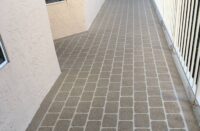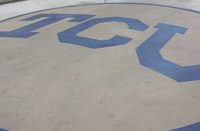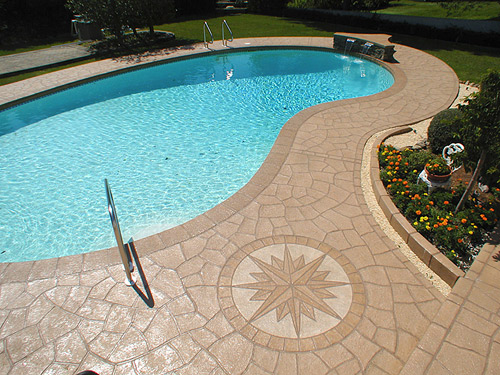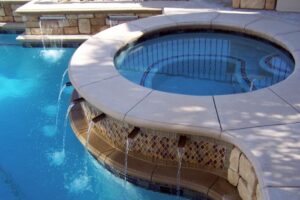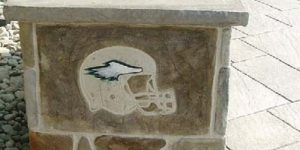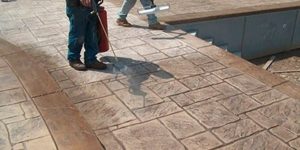Unique Concrete, a family-run business out of West Milford, N.J., stamps concrete without the stamp and texture mats of today. Instead, they use old-fashioned tools to create a layer of what they call “cast-in-place concrete tile or stone.” Here, Todd Fisher, son of Unique owner Barry Fisher, explains the company’s innovative two-part technique.
On a typical new-construction job, our company begins with the preparation of the grade and formwork. The total thickness of the concrete would depend on what type of application we are dealing with, but typically we look to pour around 5 inches.Once the grade is prepped properly, we place our rebar. We usually use 1⁄2-inch rebar unless something else is specced. We ensure that the rebar is properly elevated in preparation for the delivery of the ready-mix truck.
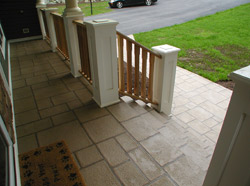 Once the truck is on site, we place the desired amount of 2 1⁄4-inch structural fibers in the mix. These fibers are Forta-Ferro, from Forta Corp., and at certain doses, they are designed to replace steel. However, we always use these in conjunction with the 1⁄2-inch steel rebar, and the dosage will depend on the job, the pattern and the desired spacing of the control joints.
Once the truck is on site, we place the desired amount of 2 1⁄4-inch structural fibers in the mix. These fibers are Forta-Ferro, from Forta Corp., and at certain doses, they are designed to replace steel. However, we always use these in conjunction with the 1⁄2-inch steel rebar, and the dosage will depend on the job, the pattern and the desired spacing of the control joints.
Since we are not stamping this part of the pour and it is for structural purposes only, we can pour a nice tight mix to keep our water-to-cement ratios low and move at a proper pace to ensure that all of the reinforcement is where it needs to be.
Once the concrete reaches a proper consistency, we use a scarifier on the surface to ensure a nice rough finish that will be ready to receive our decorative layer. We usually lay out our saw cuts and place them in the wet concrete the same day we pour the structural slab. This way we do not have to worry about creating dust. In most cases we will then come back the next day to begin our stamping process, or as we like to call it, the application of our cast-in-place concrete tile or stone.
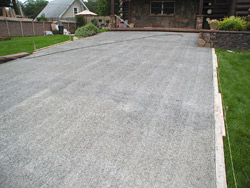 The stampable layer
The stampable layer
We begin the stamping portion of the job by getting loads of concrete sand and portland to the job, since all mixing for this step is done at each job site. We can then ensure that all of the ingredients are added to the mix, plus the proper amount of integral color, and that the portland and sands are the same shades. Since we are only stamping an inch or so of concrete, we can use integral colors and more expensive chemicals in the mix without drastically affecting the budget. (We are currently using a hydration-improving admixture from Enhance Solutions.)
Once each batch is mixed, it is wheelbarrowed into place where it is then screeded, troweled, and textured with our texture rollers. Once the texture has been applied, we will knock down the high spots to create a texture that is cooler and more comfortable for barefoot traffic while still providing slip resistance and visual pleasure. We then wait for the concrete to get to a certain consistency so it can be imprinted and hold its shape.
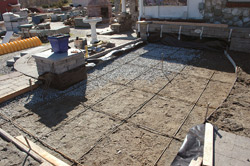
We then place our stamps or cookie cutters into the wet concrete and basically use them as platforms to work our way across the slab.
After all of the stamping is complete we come back the next day and rub the entire surface with a rubbing stone to ensure there are no rough edges. We then apply a lithium siliconate densifier to the surface for increased durability.
We will then begin our grouting process. We use a polymer-modified grout that, like the decorative concrete, is mixed on-site using integral colors. Using the same integral colors that we use for the stampable layer, we can achieve any color that the customer chooses, although recently we have had more and more customers request an uncolored grout to achieve a more natural-looking product.
The grout is applied with a traditional masonry grout bag, then tooled just as it would be done with a real stone product. Once all the excess grout is removed from the surface, we clean it all up and it is ready to be sealed. We have switched to water-based acrylics and densifiers for our sealing process, since they age much more gracefully and this product does not require resealing to maintain color differences between the grout and concrete. These sealers are also much more user-friendly and environmentally friendly.
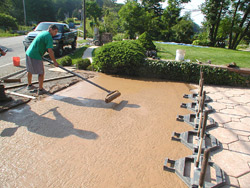
Why our process beats the mats
These are several advantages our process offers compared to using mainstream stamping and texturing tools.
Quality control. We have the ability to break the job into controlled sections regardless of the size of the job. Since the finished topping layer is only about 1 inch thick, it can be mixed on-site. This means we have total control of the portland (which can have potentially different shades), the sand (different shades and grades), the fibers, and the integral color (different lot numbers).
Usually we mix enough to go saw cut to saw cut — we mix enough material to place, trowel, texture, and stamp that section, and once that is complete we move on to the next. This is more labor-intensive, but you can move through a job at a controlled pace. This allows you to work better with changing weather conditions as well as different-size crews. This also allows more time to incorporate our saw cuts into the patterns.
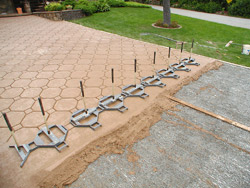
Many stamped concrete companies come back the next day and just cut right across their patterns. Since we take the race out of the job, we can take the time with certain patterns to make the saw cuts a focal point. An example of this would be creating a rowlock brick look.
Patterns are easily customized, as are medallions. Since the process is easily controlled, we can alter certain stamping tools or cookie cutters to create different patterns. This allows us to offer more patterns without having more tools laying around. While this does create more handwork by essentially requiring us to carve the wet concrete, it also lets us customize our patterns and medallions for each job. This creates a truly unique product.
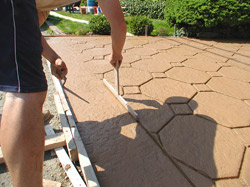
Expensive additives cost less per job. Since the topping layer is only approximately an inch in thickness, pricey integral color as well as more expensive chemicals can be added to the mix. For example, we are currently using a PMT additive from Enhance Solutions in our topping mix. This is a liquid pozzolan that offers an enormous amount of benefits, such as increased density and abrasion resistance. The negative to this type of product is the cost — it would be almost impossible to add it to a full-thickness slab and compete with regular stamped concrete or pavers. We can do it in a cost-effective manner. Likewise, integral colors can be used in a cost-effective manner since you are only coloring an inch of material. This allows for a better depth of color than the color hardeners without wasting color in a full-thickness slab.
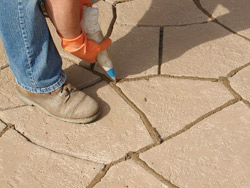
can be any color or left uncolored for a traditional look.
The work can be more heavily reinforced. If you compare this process to the process involved with wet-laying bluestone, you can begin to see the benefits. When you have to pour a slab and then worry about stamping it, usually quality and strength are sacrificed. In a lot of circumstances the mix is much wetter than is recommended and the placement of the steel reinforcement is often overlooked. Our process breaks the job up into two pours — the structural slab and the finished layer.
By just focusing on the structural slab, we can place more steel and more structural fibers than any other stamped concrete process does. We can dose the polycarboxylate in high doses to reduce water and not have to worry about finishing it. In certain situations we can add PVA fibers that approach the levels of engineered cementitious concrete (ECC), which would interfere with finishing.
Custom colors and borders can be done more easily and cost-effectively. Since everything is mixed on-site and at a minimal thickness, colors can be switched at any point in the job without having to worry about minimum orders and washout charges from the ready-mix suppliers.
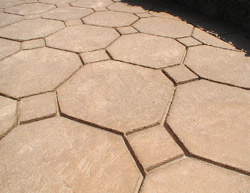
We can modify our textures from job to job. Since we use a textured roller and knockdown finish, we can adjust the amount of texture for any job condition. With mats, the texture is incorporated with the pattern, which means you don’t have many options. We can take any one of our patterns and use it on a steep sloped driveway or inside a house in a living room.
The texture is applied with the roller, then knocked down with a trowel. This also creates peaks and valleys, which makes the concrete more comfortable for barefoot traffic in the hot sun.
Pattern sizes can be adjusted for different-sized jobs. This mainly applies to two of our in-house patterns, but some others also fall into this category. For example, with our random ashlar pattern and our fieldstone we can increase or shrink the size of the shapes, so the pattern isn’t too big in a narrow sidewalk or too busy on a large patio.
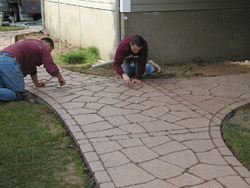
A more realistic appearance. Since our product is actually grouted with a real grout, the result is a much more realistic-looking product. We do not need to rely on stains and color releases for faux grout lines. We are not trying to mimic other products — instead, we market it as “cast-in-place concrete tile.” Since the grout joint is roughly 1⁄2 inch wide by an inch deep, the grout will last. We have seen others try to grout jobs done with mats, but there is not enough of a void created for the grout to last in a freeze/thaw climate.
This also allows us to not rely on constant resealing of our product. Most other stamped concrete needs to be resealed constantly to preserve the difference between the stamped concrete area and the faux grout lines. This is not needed with our product. This allows us to compete with concrete pavers more aggressively, since many paver installers claim stamped concrete always needs sealer, which they call a hidden cost. Also, without layers of sealer, the concrete has a more natural look.
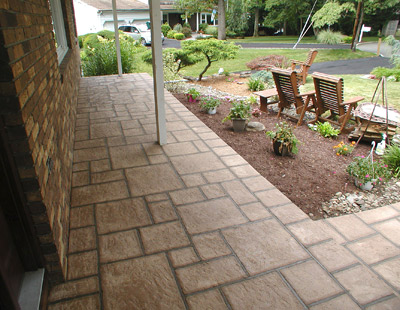 By stamping deep we reduce the risk of cracking in more obvious areas. Since we stamp so deep and wide, we create weak spots in the concrete, which helps to essentially camouflage any shrinkage cracking. If shrinkage cracks do occur, they quickly pick up one of the weak spots and follow them, and since these weak spots are grouted, the cracking is often unseen.
By stamping deep we reduce the risk of cracking in more obvious areas. Since we stamp so deep and wide, we create weak spots in the concrete, which helps to essentially camouflage any shrinkage cracking. If shrinkage cracks do occur, they quickly pick up one of the weak spots and follow them, and since these weak spots are grouted, the cracking is often unseen.
We create a resurfacing product that is very interesting. We have been able to win many resurfacing contests over the years, as well as create a product for which we can offer a lifetime guarantee against delamination in a pretty severe climate.
Finally, here are a couple of drawbacks to our method:
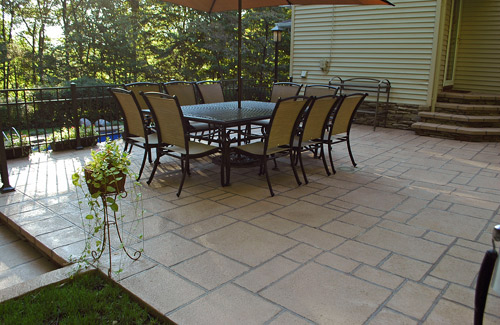 It’s very labor-intensive. Not only are we finishing the concrete, but we are also mixing it on-site. This requires a large mixer and proper supervision of the materials going into the mix. It may take nearly twice as long to complete certain jobs compared to crews using mats.
It’s very labor-intensive. Not only are we finishing the concrete, but we are also mixing it on-site. This requires a large mixer and proper supervision of the materials going into the mix. It may take nearly twice as long to complete certain jobs compared to crews using mats.
A lack of suppliers for these types of tools. Since most use mats for stamping, suppliers mainly focus on that field. This has meant that we have had to design and build many of our tools that we use. This can also be seen as a benefit, since it makes us one-of-a-kind and the only ones in the country with certain patterns.
